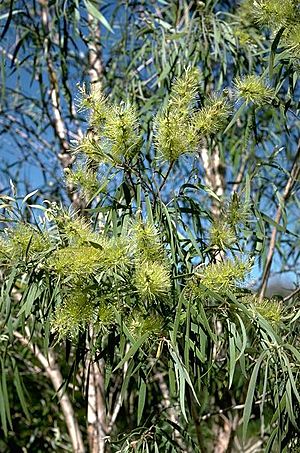Silver cajuput facts for kids
Quick facts for kids Silver cajuput |
|
|---|---|
 |
|
| Scientific classification | |
| Genus: |
Melaleuca
|
| Species: |
argentea
|
The Silver Cajuput (Melaleuca argentea) is a special tree found only in northern Australia. It's also called the silver cadjeput or silver-leaved paperbark. This tree belongs to the myrtle family, called Myrtaceae. You often see it growing near rivers or in swampy areas in warm, tropical places. It has bark that feels like paper and branches that hang down. Scientists have studied this tree a lot.
Contents
What the Silver Cajuput Looks Like
The Silver Cajuput is usually a tree about 8 m (30 ft) tall. Sometimes, it can grow as tall as 20 m (70 ft). Its leaves grow one after another along the branches. They are shaped like an oval, or sometimes they are straight or curved like a sickle. Each leaf is about 50–130 mm (2–5 in) long and 7–24 mm (0.3–0.9 in) wide. They have 5 to 9 lines running down their length.
Older leaves are a pale, shiny silver-green. New leaves are soft and silvery, covered with tiny, silky hairs. If you crush the leaves, they smell nice.
Silver Cajuput Flowers and Fruit
The flowers grow in spikes at the ends of the branches. The branches keep growing even after the flowers bloom. Sometimes, flowers also grow where the leaves meet the branch. Each spike has 5 to 20 groups of three flowers. These spikes can be up to 30 mm (1 in) across.
The petals of the flowers are about 3 mm (0.1 in) long. They fall off as the flower gets older. Inside the flower, there are 5 groups of stamens (the parts that make pollen). Each group has 7 to 9 stamens. Silver Cajuput trees can flower almost any time of the year. After flowering, they produce woody, cup-shaped fruits. These fruits are about 3–4 mm (0.1–0.2 in) wide and are spaced out along the branches.
How it Got its Name
The Silver Cajuput was first officially described in 1918. A scientist named William Fitzgerald wrote about it. He found samples of the tree near rivers like the Isdell and Fitzroy in Western Australia.
The scientific name argentea comes from a Latin word. Argenteus means "silvery." This name perfectly describes the tree's shiny, silver-green leaves.
Where the Silver Cajuput Lives
You can find the Silver Cajuput in several parts of northern Australia. It grows in the Kimberley area of Western Australia. It's also found in the Top End of the Northern Territory and in northern Queensland.
These trees often grow in forests along wet, swampy areas. They like places similar to where another tree, Melaleuca quinquenervia, grows. In the far northern coastal parts of the wet tropics, the Silver Cajuput often takes the place of Melaleuca quinquenervia.
Life Cycle of the Silver Cajuput
The Silver Cajuput tree can live for more than 20 years. It starts making seeds when it is about 6 to 10 years old. If there is a fire, this tree can recover well. It regrows from a special woody swelling at its base called a lignotuber.
Is the Silver Cajuput Safe?
The Silver Cajuput is considered "not threatened" in Western Australia. This means it is not in danger of disappearing. The Government of Western Australia Department of Parks and Wildlife keeps track of its status.
How People Use the Silver Cajuput
Growing in Gardens
This tree is known as a "handsome, weeping, silver-leaved tree." This means it looks beautiful with its hanging branches and silvery leaves. It's a good choice for gardens in tropical and sub-tropical areas. For example, people plant it as an ornamental tree in Brisbane.
Scientific Studies
Scientists have studied the Silver Cajuput to understand how much water it uses. This research happened in the Pilbara region of Western Australia. Knowing how the tree uses water helps predict how it will react if water levels change over time. Scientists also looked at how much water it uses each day and each season.
This information is very important. Trees along riverbanks help keep the water clean. They provide shade, which keeps the water cool. They also help keep the riverbanks strong and prevent soil from washing away. Areas with trees along rivers are important pathways for wildlife. They often have more different kinds of plants and animals than other places.

